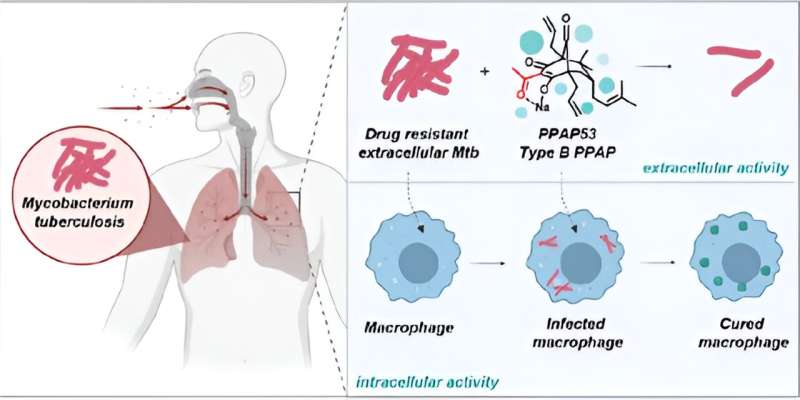This article has been reviewed according to Science X's editorial process and policies. Editors have highlighted the following attributes while ensuring the content's credibility:
fact-checked
peer-reviewed publication
trusted source
proofread
Novel compounds show promise in the fight against tuberculosis and neurodegenerative disease

Prof. Bernd Plietker and his research group at the Chair of Organic Chemistry I at TUD have specifically developed a class of natural substances—polyprenylated polycyclic acylphloroglucinols (PPAP for short). Due to its properties, the resulting derivative PPAP53 is characterized by great potential for application in a medicinal chemistry context. In collaboration with several research institutions, such as the Universities of Ulm and Mainz, it has been shown that PPAP53 is very promising in the fight against multi-resistant tuberculosis and opens up new treatment perspectives for neurodegenerative diseases.
The results of the extensive research work were published in two consecutive papers in the Journal of Medicinal Chemistry.
Tuberculosis (TB) is a prevalent infectious disease that affects millions of people each year. It was previously the leading cause of death from a single pathogen before the COVID-19 pandemic. Detecting TB early is challenging because the bacterium Mycobacterium tuberculosis (Mtb) can hide in human macrophages, which are part of the immune system. This makes it difficult for conventional diagnostic methods to detect the infection until the macrophages collapse, leading to "open tuberculosis."
TB can be treated with common antibiotics, but the repeated exposure of Mtb to these drugs can result in the development of multidrug-resistant and extensively drug-resistant strains. This highlights the importance of finding alternative treatment options to combat this challenging disease.
A few years ago, Prof. Bernd Plietker made a promising new class of natural substance-based active compounds accessible by developing a short and parallelizable total synthesis: polyprenylated polycyclic acylphloroglucinols (PPAP for short). "Initial studies on the antimicrobial activity of the non-natural derivatives we developed already indicated that this class of molecules offers the potential for application in a medicinal chemistry context through interactions with membrane-associated proteins," explains Bernd Plietker, who has held the Chair of Organic Chemistry I at TU Dresden since 2020.
Building on these initial results, he and his team, in cooperation with Prof. Steffen Stenger from Ulm University Hospital, have now been able to show that a specific PPAP, PPAP53, is able to activate human macrophages to fight resistant tuberculosis bacteria without being toxic to the macrophages themselves.
Fighting TB within macrophages is a promising way of successfully combating the infection at an early stage and thus avoiding the development of resistance long before the symptoms of infection appear. Several tests have shown that PPAP53 exclusively fights intracellular TB by passing through or activating the cell membrane without damaging the macrophage.
A further advantage of PPAP53 over existing drugs is that it does not lead to an increase in the concentration of liver enzymes. This prevents a decrease in the effectiveness of the treatment due to the undesired degradation of the active substance in the liver. In addition, cross-resistance with other therapeutic agents is avoided, which benefits the overall treatment of tuberculosis.
In the second publication, the assumption was investigated that the observed PPAP-dependent activation of macrophages could be the result of an interaction with membrane-associated receptors or channels. To this end, TRPC6 ion channels, which are responsible for the targeted transport of calcium ions through the cell membrane, were investigated. They are mainly found in neuronal cells and the adrenal cortex.
"In a combination of biological experiments and with the support of modern artificial intelligence algorithms, we were able to show that PPAP53 binds highly specifically to the C-terminus of this TRPC channel and opens it for calcium transport. PPAP53 thus has a similar effect to the well-known active ingredient hyperforin, which is derived from St. John's wort and is also used as an antidepressant.
"In contrast to hyperforin, however, PPAP53 does not cause an increase in liver enzymes and thus avoids cross-resistance. The complete water solubility of PPAP53 significantly increases its bioavailability, while the specific substitution on the natural substance body achieves complete light stability. Phototoxic side effects were one of the main disadvantages of hyperforin, in addition to the increase in liver enzyme concentrations.
"For the first time, we have now been able to derive a molecular understanding of the structure-activity relationship of our active substance PPAP53. The unique properties of PPAP53 open up fascinating perspectives in various medical fields, for example in macrophage therapy, oncology and neurological diseases," says first author Philipp Pelsalz, explaining the potential of the new active compound.
More information: Philipp Peslalz et al, Unnatural Endotype B PPAPs as Novel Compounds with Activity against Mycobacterium tuberculosis, Journal of Medicinal Chemistry (2023). DOI: 10.1021/acs.jmedchem.3c01172
Philipp Peslalz et al, Selective Activation of a TRPC6 Ion Channel Over TRPC3 by Metalated Type-B Polycyclic Polyprenylated Acylphloroglucinols, Journal of Medicinal Chemistry (2023). DOI: 10.1021/acs.jmedchem.3c01170
Journal information: Journal of Medicinal Chemistry
Provided by Dresden University of Technology




















